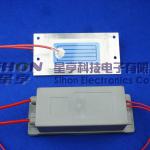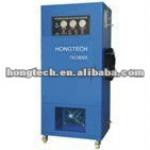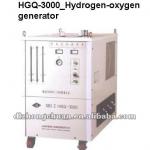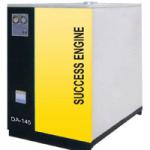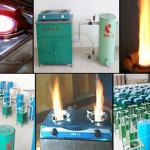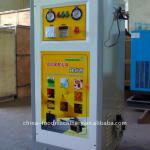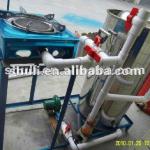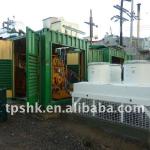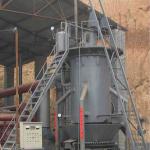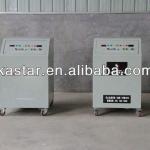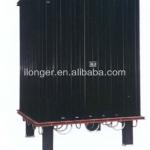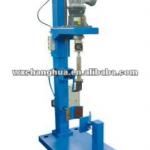Coal Gasifier Plant Sell Well India Market
| Condition:New | Place of Origin:Henan China (Mainland) | Brand Name:Dongfang | Model Number:QM-1.3 |
| Usage:hydrogen,methane,carbon monoxide | Production Rate:high | Voltage:380-440V | Power(W):4.5kw |
| Weight:5800kg | Certification:CE & ISO9001:2008 | Warranty:two years | After-sales Service Provided:Engineers available to service machinery overseas |
| scope of application1:machinery, heat source | scope of application2:metallurgy, chemistry, | scope of application3:glass, building materials, food, textile and light industries. | Material:Q235 and the boiler steel plate |
| operate:simple | environment:non-pollution | Consumption cost:low | The full combustion:yes |
| Color:As your requirement | OEM:Supply |
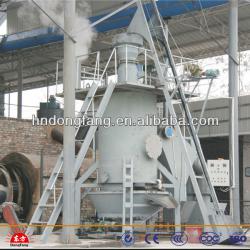
Coal Gasifier Plant Sell Well India Market !
1. Coal Gasifier Plant is the process of producing coal gas, a type of syngas–a mixture of carbon monoxide (CO), hydrogen (H2), carbon dioxide (CO2) and water vapour (H2O)–from coal and water. Coal gas, which is a combustible gas, was traditionally used as a source of energy for municipal lighting and heat before the advent of industrial-scale production of natural gas, while the hydrogen obtained from gasification can be used for various purposes such as making ammonia, powering a hydrogen economy, or upgrading fossil fuels. Alternatively, the coal gas (also known as "town gas") can be converted into transportation fuels such as gasoline and diesel through additional treatment via the Fischer-Tropsch process.
2.Process of the Coal Gasifier Plant
During gasification, the coal is blown through with oxygen and steam (water vapor) while also being heated (and in some cases pressurized). If the coal is heated by external heat sources the process is called "allothermal", while "autothermal" process assumes heating of the coal via exothermal chemical reactions occurring inside the gasifier itself. It is essential that the oxidizer supplied is insufficient for complete oxidizing (combustion) of the fuel. During the reactions mentioned, oxygen and water molecules oxidize the coal and produce a gaseous mixture of carbon dioxide (CO2), carbon monoxide (CO), water vapour (H2O), and molecular hydrogen (H2). (Some by-products like tar, phenols, etc. are also possible end products, depending on the specific gasification technology utilized.) This process has been conducted in-situ within natural coal seams (referred to as underground coal gasification) and in coal refineries. The desired end product is usually syngas (i.e., a combination of H2+ CO), but the produced coal gas may also be further refined to produce additional quantities of H2:
- 3C (i.e., coal) + O2+ H2O → H2+ 3CO
If the refiner wants to produce alkanes (i.e., hydrocarbons present in natural gas, gasoline, and diesel fuel), the coal gas is collected at this state and routed to a Fischer-Tropsch reactor. If, however, hydrogen is the desired end-product, the coal gas (primarily the CO product) undergoes the water gas shift reaction where more hydrogen is produced by additional reaction with water vapor:
- CO + H2O → CO2+ H2
Although other technologies for coal gasification currently exist, all employ, in general, the same chemical processes. For low-grade coals (i.e., "brown coals") which contain significant amounts of water, there are technologies in which no steam is required during the reaction, with coal (carbon) and oxygen being the only reactants. As well, some coal gasification technologies do not require high pressures. Some utilize pulverized coal as fuel while others work with relatively large fractions of coal. Gasification technologies also vary in the way the blowing is supplied.
"Direct blowing"assumes the coal and the oxidizer being supplied towards each other from the opposite sides of the reactor channel. In this case the oxidizer passes through coke and (more likely) ashes to the reaction zone where it interacts with coal. The hot gas produced then passes fresh fuel and heats it while absorbing some products of thermal destruction of the fuel, such as tars and phenols. Thus, the gas requires significant refining before being used in the Fischer-Tropsch reaction. Products of the refinement are highly toxic and require special facilities for their utilization. As a result, the plant utilizing the described technologies has to be very large to be economically efficient. One of such plants called SASOL is situated in the Republic of South Africa (RSA). It was built due to embargo applied to the country preventing it from importing oil and natural gas. RSA is rich in Bituminous coal and Anthracite and was able to arrange the use of the well known high pressure "Lurgi" gasification process developed in Germany in the first half of 20-th century.
"Reversed blowing"(as compared to the previous type described which was invented first) assumes the coal and the oxidizer being supplied from the same side of the reactor. In this case there is no chemical interaction between coal and oxidizer before the reaction zone. The gas produced in the reaction zone passes solid products of gasification (coke and ashes), and CO2and H2O contained in the gas are additionally chemically restored to CO and H2. As compared to the "direct blowing" technology, no toxic by-products are present in the gas: those are disabled in the reaction zone. This type of gasification has been developed in the first half of 20-th century, along with the "direct blowing", but the rate of gas production in it is significantly lower than that in "direct blowing" and there were no further efforts of developing the "reversed blowing" processes until 1980-s when a Soviet research facility KATEKNIIUgol' (R&D Institute for developing Kansk-Achinsk coal field) began R&D activities to produce the technology now known as "TERMOKOKS-S"[1] process. The reason for reviving the interest to this type of gasification process is that it is ecologically clean and able to produce two types of useful products (simultaneously or separately): gas (either combustible or syngas) and middle-temperature coke. The former may be used as a fuel for gas boilers and diesel-generators or as syngas for producing gasoline, etc., the latter - as a technological fuel in metallurgy, as a chemical absorbent or as raw material for household fuel briquettes. Combustion of the product gas in gas boilers is ecologically cleaner than combustion of initial coal. Thus, a plant utilizing gasification technology with the "reversed blowing" is able to produce two valuable products of which one has relatively zero production cost since the latter is covered by competitive market price of the other. As the Soviet Union and its KATEKNIIUgol' ceased to exist, the technology was adopted by the individual scientists who originally developed it and is now being further researched in Russia and commercially distributed worldwide. Industrial plants utilizing it are now known to function in Ulaan-Baatar (Mongolia) and Krasnoyarsk (Russia).
3. Technical Parameters of Coal Gasifier Plant :
photos of the Coal Gasifier Plant :

| Packaging Detail:Standard export sea worthy packing or as per your requirementsCoal Gasifier Plant Sell Well India Market |
| Delivery Detail:25-30days |



